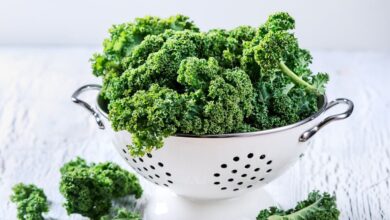
Black raspberry vs raspberry: A fascinating comparison of these two similar yet distinct berries. From their origins and growth regions to their nutritional profiles and culinary applications, this exploration delves into the differences and similarities between these flavorful fruits. We’ll uncover the history behind each, examine their nutritional content, and explore how they’re used in the kitchen.
Both black raspberries and raspberries are popular berries with a long history of use. This detailed comparison will cover everything from their appearance and flavor profiles to their growing conditions and culinary applications, allowing you to make an informed choice next time you’re selecting berries for your recipes.
Black Raspberries vs. Raspberries: A Deeper Dive
Black raspberries and raspberries, both popular berries, often get confused. While visually similar, they differ in flavor, appearance, and even in their cultivation history. This exploration delves into the nuances of these two delectable fruits, highlighting their distinct characteristics and backgrounds.The difference between black and red raspberries often boils down to the pigment and flavor profile. Black raspberries exhibit a deeper color and a more intense, sometimes slightly tart flavor.
Red raspberries, on the other hand, have a sweeter and more delicate taste. Understanding these distinctions allows for a more informed appreciation of both fruits.
Cultivation and History
Black raspberries have a slightly more recent history of cultivation compared to their red counterparts. Early cultivation of red raspberries dates back to ancient times, with evidence suggesting their presence in various European gardens for centuries. Their popularity grew through the centuries as their cultivation spread and their versatility in culinary applications became known. Black raspberries, while not as ancient, have also seen a steady increase in popularity due to their unique flavor profile.
The history of cultivation for both types is closely intertwined with the development of gardening techniques and agricultural practices.
Geographical Distribution
Both black and red raspberries thrive in temperate climates. Red raspberries are more widely adaptable, found in a broader range of regions, from the cool, damp climates of the Pacific Northwest to the warmer, sunnier regions of the southern United States. Black raspberries, while not as geographically widespread as red raspberries, are still found in various temperate regions, often in cooler climates.
Their ideal growing conditions tend to be more specific, impacting their cultivation areas.
Comparative Analysis
| Characteristic | Black Raspberry | Red Raspberry |
|---|---|---|
| Common Name | Black Raspberry | Raspberry |
| Scientific Name | Rubus occidentalis | Rubus idaeus |
| Family | Rosaceae | Rosaceae |
This table highlights the core botanical classifications of both types of raspberries. Knowing their scientific names and family affiliation allows for a more accurate understanding of their place in the plant kingdom. These classifications often indicate shared characteristics and evolutionary relationships.
Nutritional Composition

Black raspberries and raspberries, though visually similar, offer distinct nutritional profiles that contribute to their respective health benefits. Understanding these differences can inform dietary choices and maximize the potential advantages of consuming either fruit. The nutritional composition of each fruit plays a crucial role in its potential health benefits, offering valuable vitamins, minerals, and antioxidants.The nutritional content of black raspberries and raspberries often depends on factors such as growing conditions, ripeness, and processing methods.
While both are excellent sources of antioxidants, black raspberries often display higher concentrations of certain beneficial compounds, potentially influencing their health benefits. Comparing the nutritional values per 100g serving offers a clear perspective on the nuances between the two.
Vitamin and Mineral Content
Both black raspberries and raspberries are rich in various vitamins and minerals, essential for maintaining overall health. Black raspberries often demonstrate higher levels of certain vitamins and minerals compared to their red counterparts. This variation in nutritional composition can influence their individual health benefits.
Antioxidant Power
Antioxidants are crucial for protecting the body from damage caused by free radicals. Both black raspberries and raspberries are excellent sources of antioxidants, primarily due to the presence of various polyphenols. The specific types and concentrations of these polyphenols can vary between the two, contributing to potential differences in their antioxidant capacities.
Macronutrient Comparison
The macronutrient composition of black raspberries and raspberries plays a significant role in their impact on overall health. A comparison of their macronutrient profiles reveals key differences, particularly in sugar and fiber content, which can influence their impact on blood sugar levels.
Nutritional Values (per 100g)
| Nutrient | Black Raspberries | Raspberries |
|---|---|---|
| Calories | 40-50 | 40-55 |
| Protein (g) | 0.7-1.2 | 0.7-1.0 |
| Carbohydrates (g) | 10-12 | 10-12 |
| Fiber (g) | 2.5-3.5 | 2.0-3.0 |
| Sugar (g) | 6-8 | 6-8 |
Note: Values are approximate and may vary depending on growing conditions and ripeness.
Sugar and Fiber Differences
The sugar content in both black raspberries and raspberries is relatively similar. However, the fiber content of black raspberries often surpasses that of raspberries. This difference in fiber content can affect satiety and the rate at which the body absorbs sugars. High fiber content can help manage blood sugar levels more effectively. For example, individuals with diabetes may benefit from the higher fiber content of black raspberries in managing blood sugar fluctuations.
Flavor and Sensory Characteristics: Black Raspberry Vs Raspberry
Black raspberries and raspberries, though both members of the Rosaceae family, exhibit distinct flavor profiles that set them apart. Beyond the obvious visual difference, these differences in taste and texture contribute to their unique appeal in culinary applications. Understanding these nuances allows for a more informed appreciation and selection of these fruits.
Flavor Profiles
Black raspberries boast a complex flavor profile that often leans toward a deeper, more intense taste than their red counterparts. The flavor can be described as a blend of sweet and tart notes, with hints of dark fruit like plum or blackberry. Raspberries, on the other hand, typically exhibit a brighter, more delicate flavor, with a more pronounced sweetness and a subtle tartness.
This difference in intensity contributes to their versatility in various culinary applications.
Aroma
The aroma of black raspberries is often described as more intense and suggestive of a concentrated fruit. It’s a richer, fuller scent that evokes images of ripe, dark berries. Raspberries, conversely, generally display a lighter, more delicate aroma that is reminiscent of a freshly picked summer fruit. The subtle yet distinct differences in aroma contribute to the unique sensory experience of each fruit.
Texture
Black raspberries typically have a slightly firmer texture than raspberries. This firmness can provide a satisfying crunch or a soft, yielding texture, depending on ripeness. Raspberries, conversely, are often described as softer and more delicate. Their texture tends to be more easily crushed or mashed, making them ideal for certain recipes where a smoother consistency is desired.
Sweetness and Tartness
A key distinction between the two lies in their sweetness and tartness levels. Black raspberries usually display a balance of sweetness and tartness, with a slightly more prominent tart component compared to the more pronounced sweetness of raspberries. This variation in sweetness and tartness directly influences the best culinary uses for each fruit.
Culinary Uses
| Fruit | Culinary Use |
|---|---|
| Black Raspberries | Jam, preserves, pies, sauces, smoothies, cocktails, desserts, baked goods |
| Raspberries | Jam, pies, cobblers, sauces, desserts, yogurt toppings, ice cream, salads, smoothies, cocktails |
The table above highlights the diverse applications of each fruit. Black raspberries, with their richer flavor, are often used in recipes where a more intense fruit flavor is desired. Raspberries, with their sweeter profile, are frequently used in desserts and as toppings for various dishes. The choice of fruit in a particular recipe will be heavily influenced by the desired flavor and textural outcome.
Cultivation and Harvesting
Black raspberries and raspberries, while both members of the Rosaceae family, exhibit subtle yet significant differences in their cultivation and harvesting needs. Understanding these distinctions is crucial for successful cultivation and ensuring optimal fruit quality. These differences are largely due to their varied responses to environmental factors and their distinct growth patterns.Cultivating these berries successfully involves careful attention to soil type, sunlight exposure, and pest management.
Harvesting methods also play a critical role in preserving the berries’ quality and minimizing damage. The timing of harvest directly influences the final product, impacting both taste and shelf life.
Growing Conditions for Black Raspberries
Black raspberries often thrive in slightly cooler climates compared to their red counterparts. They generally prefer well-drained soil that is rich in organic matter. Consistent moisture is vital for healthy growth, but waterlogging should be avoided. Black raspberries also need full sun exposure for optimal fruit production.
Growing Conditions for Raspberries
Raspberries, particularly red raspberries, are more adaptable to a wider range of growing conditions. They can tolerate a broader range of soil types, though well-drained soil is preferred. While full sun is ideal, raspberries can also tolerate partial shade. The specific needs vary slightly depending on the variety.
Cultivation Methods
Both black raspberries and raspberries are typically grown from established plants, either through seedlings or by planting established canes. Planting in rows allows for easier access during harvesting. Pruning is a crucial aspect of cultivation for both types, promoting healthy growth and yield. Mulching can help retain moisture and suppress weeds.
Harvesting Methods
Harvesting black raspberries and raspberries involves picking the ripe berries by hand. Using appropriate tools, such as harvesting baskets or trays, can help to prevent bruising and preserve the berries’ quality. Careful handling during harvesting minimizes damage and improves the fruit’s longevity. Timing is crucial as picking too early results in underripe berries and picking too late leads to overripe, mushy berries.
Growing Seasons
The growing season for both black raspberries and raspberries typically begins in spring and extends into summer, depending on the specific variety and local climate. The duration of the growing season influences the timing of the harvest. In regions with shorter growing seasons, the yields may be reduced.
Impact of Climate and Soil Conditions on Yield and Quality
Climate significantly impacts the yield and quality of both types of berries. Regions with consistent temperatures and adequate rainfall typically produce higher yields and better quality fruit. Soil conditions also play a pivotal role. Well-drained, nutrient-rich soil supports robust growth and leads to larger, sweeter berries. For example, in regions with excessively hot summers, raspberries may suffer from sunburn, resulting in lower quality berries.
In areas with cold winters, proper plant protection is crucial for survival. Soil pH also impacts nutrient availability and thus, the overall quality of the berry.
Culinary Applications
Black raspberries and raspberries, with their distinct flavors and textures, are delightful additions to countless culinary creations. From sweet jams and pies to vibrant sauces and refreshing beverages, these berries offer a wide range of possibilities in the kitchen. This section delves into the diverse culinary uses of both fruits, highlighting preservation methods and showcasing popular recipes.These small jewels of nature are not just aesthetically pleasing; they also possess a wide array of culinary applications.
Ever wondered about the subtle differences between black raspberries and regular raspberries? While both are delicious, incorporating more berries into a healthy diet is crucial, especially for older adults. A recent study shows the quality of diet for older adults has declined significantly. Fortunately, there are simple ways to improve this. Check out quality of diet for older adults has declined heres how to fix it for some actionable advice.
Ultimately, the slight differences in flavor and texture between black and regular raspberries are easily overshadowed by the overall nutritional boost they offer, making them both excellent choices for a healthy diet.
Their unique characteristics—from the deep, fruity flavor of black raspberries to the slightly tart sweetness of raspberries—lend themselves beautifully to various food preparations, from sweet treats to savory dishes. This exploration emphasizes the versatility of both fruits, revealing their potential in baking, desserts, and other food preparations.
Ever wondered about the subtle differences between black raspberries and regular raspberries? While the flavor profiles are distinct, it’s fascinating how some teens are finding remote schooling less anxiety-inducing, as seen in this insightful article on some teens experiencing lower levels of anxiety with remote schooling. Ultimately, both black raspberries and regular raspberries offer a burst of deliciousness, depending on your personal preference.
The sweetness and texture differences are truly worth exploring.
Recipes and Culinary Uses
Black raspberries and raspberries are incredibly versatile fruits, readily adaptable to various culinary applications. Their distinct flavors make them ideal for jams, pies, sauces, and beverages. Their adaptability extends to baking and desserts, where their vibrant colors and textures elevate the overall appeal and taste.
- Jams and Jellies: The high pectin content in both fruits makes them excellent for jams and jellies. Black raspberries, with their intense flavor, lend themselves well to rich, bold jams, while raspberries, with their more delicate flavor, produce lighter, more subtly sweet jams. Proper preservation techniques are crucial for maintaining the quality and freshness of these homemade delights.
- Pies and Tarts: Both fruits are delightful in pies and tarts. The tartness of raspberries pairs well with a buttery, flaky crust, while the rich flavor of black raspberries works beautifully with a more robust crust. The addition of spices like cinnamon or nutmeg can enhance the overall flavor profile.
- Sauces and Chutneys: Black raspberries and raspberries can be transformed into vibrant sauces and chutneys. The combination of fruit, spices, and other ingredients creates flavorful additions to savory dishes, offering a sweet and tangy element.
- Beverages: Fresh black raspberries and raspberries can be incorporated into refreshing beverages, such as smoothies, juices, and syrups. These beverages offer a naturally sweet and healthy alternative to sugary drinks.
Preservation Techniques
Preserving black raspberries and raspberries ensures their availability throughout the year and allows you to enjoy their unique flavors at any time. Proper preservation methods are essential for maintaining the fruit’s quality, texture, and flavor.
- Freezing: Freezing is a popular preservation method for both fruits. Freezing berries quickly, ideally within a few hours of picking, helps to maintain their texture and flavor. Freezing preserves the natural sweetness and vibrant color of the berries.
- Drying: Drying berries concentrates their flavor and reduces their moisture content. This method is particularly useful for creating long-lasting supplies of fruit for use in baking or as a snack. Properly dried berries retain their flavor and color.
- Canning: Canning is a traditional method for preserving fruits, including black raspberries and raspberries. This method involves processing the fruit in sterilized jars to eliminate harmful bacteria and preserve them for later use.
Baking and Dessert Applications
Black raspberries and raspberries add a unique touch to various baking and dessert recipes. Their versatility allows for incorporating them into a wide range of treats, from cakes and muffins to crumbles and pies.
- Cakes and Muffins: Both fruits add a beautiful color and flavor to cakes and muffins. The sweetness of the berries complements the moist texture of the baked goods.
- Crumbles and Cobblers: Black raspberries and raspberries make delicious toppings for crumbles and cobblers. The combination of the fruit and the topping creates a delightful contrast of textures and flavors.
- Compotes and Chutneys: The unique flavors of black raspberries and raspberries make them ideal for compotes and chutneys. The resulting treats add a touch of sweetness and complexity to desserts.
Popular Recipes
Here are three popular recipes for each fruit, showcasing their versatility in the kitchen:
| Fruit | Recipe 1 | Recipe 2 | Recipe 3 |
|---|---|---|---|
| Black Raspberries | Black Raspberry Jam | Black Raspberry Crumble | Black Raspberry Smoothie |
| Raspberries | Raspberry Pie | Raspberry Jam | Raspberry Sorbet |
Market Trends and Availability
The market for both black raspberries and raspberries is dynamic, influenced by factors like consumer preferences, production costs, and global trade. Understanding these trends helps consumers make informed decisions and businesses adapt to changing demands. Current market conditions and availability fluctuate based on factors such as weather patterns, pest infestations, and overall growing conditions.Recent years have shown a growing demand for both black raspberries and raspberries, driven by increasing consumer awareness of their nutritional benefits.
This increased interest translates into higher prices and potentially limited availability, especially during peak seasons. Global supply chains also play a significant role in determining the availability and cost of these fruits in various markets.
Current Market Trends
The global demand for berries, including black raspberries and raspberries, is consistently high, driven by health-conscious consumers and growing interest in fresh produce. This demand often outpaces supply, leading to price fluctuations and potential shortages during peak seasons. Additionally, the increasing popularity of berry-based products, from jams and sauces to smoothies and baked goods, fuels the demand further.
Factors Influencing Price and Supply
Several factors influence the price and supply of both black raspberries and raspberries. Weather conditions, particularly during the growing season, are a significant factor. Droughts, floods, or extreme temperatures can negatively impact yields, driving up prices. Pest infestations and diseases also affect crop output and quality, potentially leading to supply constraints. Labor costs associated with harvesting and processing contribute to the overall production costs.
Transportation and logistics play a crucial role in the final price consumers pay, particularly for imported fruits. Finally, fluctuating global market conditions, including international trade agreements and exchange rates, can affect the prices of both fruits.
Recent Innovations in Production and Processing
Recent advancements in agricultural practices and processing technologies are impacting both black raspberry and raspberry production. Hydroponic and vertical farming techniques are gaining traction, allowing for year-round production and reduced environmental impact. Additionally, improved pest control methods and disease resistance varieties are helping farmers increase yields and maintain fruit quality. Innovations in packaging and preservation technologies are extending the shelf life of the fruit, minimizing waste and ensuring better availability throughout the year.
Typical Pricing Per Pound (USD)
| Region | Black Raspberries | Raspberries |
|---|---|---|
| North America (US/Canada) | $6-$12 | $4-$8 |
| Western Europe | $8-$15 | $6-$12 |
| Australia | $7-$14 | $5-$10 |
| South America | $5-$9 | $3-$7 |
Note
* Prices are approximate and can vary based on seasonality, quality, and specific growing conditions.
Comparing black raspberries to regular raspberries is a fun little side-dish in the world of berry appreciation, but it’s nothing compared to the alarming rise of the secondary drug industry, booming amid the opioid epidemic. This booming market, highlighted in a recent article on the secondary drug industry booming amid opioid epidemic , is a serious problem.
Ultimately, though, both black and regular raspberries offer delicious, healthy options for a sweet treat, unlike the potential dangers of the unregulated drug market.
Visual Representation

Black raspberries and raspberries, though both members of the Rosaceae family, exhibit distinct visual characteristics that allow for easy differentiation. These differences are particularly apparent in their size, shape, color, and skin texture, which play crucial roles in both aesthetic appeal and consumer recognition. Understanding these visual distinctions is essential for both consumers and industry professionals.Visual identification is a critical aspect of both the consumer experience and the commercial handling of these berries.
Recognizing the visual nuances between black raspberries and raspberries aids in proper sorting, grading, and ultimately, in consumer satisfaction.
Size and Shape
The size and shape of these berries are key visual differentiators. Black raspberries tend to be slightly larger than their red counterparts. Their shape is often described as more rounded or plump, compared to the often more elongated or oval-shaped raspberries. This difference in shape is readily apparent in visual comparisons.
Color
The color difference between black raspberries and raspberries is striking and readily observable. Black raspberries exhibit a deep, rich black color, often with a slight sheen, whereas raspberries showcase a vibrant red hue, ranging from light pink to a deep crimson. The intensity of color can vary based on ripeness.
Skin Texture
The skin texture of both fruits contributes to their overall visual appeal. Black raspberries typically possess a smooth skin, while raspberries frequently have a slightly fuzzy or hairy texture. This difference in skin texture is another noticeable aspect in visual comparisons.
Ripeness Stages, Black raspberry vs raspberry
The visual characteristics of both fruits change noticeably throughout the ripening process. Unripe black raspberries are a greenish-black color, while unripe raspberries are a pale, less vibrant red. As they ripen, black raspberries intensify to a glossy black, and raspberries deepen to a rich crimson, indicating the fruit’s optimal stage for consumption.
| Characteristic | Black Raspberry | Raspberry |
|---|---|---|
| Size | Slightly larger, more rounded | Smaller, often elongated |
| Color (ripe) | Deep, rich black, sometimes with a sheen | Vibrant red, ranging from light pink to deep crimson |
| Skin Texture | Smooth | Slightly fuzzy or hairy |
| Color (unripe) | Greenish-black | Pale, less vibrant red |
| Shape (ripe) | Plump, rounded | Oval-shaped |
The table above illustrates the visual distinctions between the two berries. Observing these features, especially in different stages of ripeness, facilitates accurate identification and selection for optimal consumption and commercial use.
Ultimate Conclusion
In conclusion, while black raspberries and raspberries share some similarities, their distinct characteristics make them ideal for different applications. Their nutritional content, flavor profiles, and culinary uses set them apart, offering a range of options for consumers. Whether you’re a seasoned cook or a casual berry enthusiast, understanding these differences will enhance your enjoyment of these delicious fruits. Hopefully, this comparison has shed light on the nuances of these popular berries.





